| Français | Contact Us | Help | Search | Canada Site | |
| Home | News Releases | Key Rural Initiatives |
Site Map | Publications |
Canadian Rural Partnership
Rural Team Yukon Yukon Priorities: ©Her Majesty the Queen in Right of Canada, 2002 ISBN No. 0-662-32950-3, Cat. No. A22-271/2002E-IN Agriculture and Agri-Food Canada Publication Number 2145/E Prepared for the Rural Secretariat Acknowledgements This survey was carried out under the direction of the Rural Secretariat. Many federal departments also contributed to the development of the survey instrument. The survey was conducted by DataPath Systems based in Whitehorse, Yukon. Special appreciation is extended to Joerg Hannes of the Rural Secretariat for his invaluable support and direction for this project. This study would not have been possible without the willing cooperation of the 902 Yukoners who participated in this survey.
A. INTRODUCTION B. RESEARCH DESIGN In the spring of 2001, 902 telephone surveys were completed by the data collection agency (DataPath Systems), for a response rate of 36%. With a sample size of over 900 respondents, we can be certain that 95% of the time the total sample results are accurate within a range of plus or minus 3.2 percentage points. C. RELATIVE IMPORTANCE OF PRIORITIES
Youth:
Community Development and the Environment:
I. CONCLUSIONS AND RECOMMENDATIONS
This report presents findings from a representative survey of Yukoners. The research is part of an ongoing 'Rural Dialogue' initiated by the federal government in its 1998 Federal Framework for Action in Rural Canada. Through a series of interactive communication processes, the Dialogue was initiated to learn more about developmental concerns held by rural Canadians and to engage this sub-population of Canadians in community development. One outcome of the Dialogue has been the identification by rural Canadians of eleven priority areas of action. The Rural Secretariat has sought to explore more thoroughly Yukoners' views of these priorities by conducting this study. The survey also included questions about more detailed information on the priorities and other related areas that can be used by government departments for policy and program development. The core of the report (Sections C through H), presents the results of a random telephone survey of 902 residents of the Yukon. The report begins with an analysis of the importance Yukoners place on the eleven priorities (Section C) followed by their ratings of how well government is doing in providing the priorities to their community (Section D). Section E ties together the importance of the priorities and their ratings into a government-attention grid by allocating each priority to one of three levels of attention (low, medium, and high). This attention grid can be used by government as a guideline in determining which priorities need more immediate attention than others. Subsequent sections present more detailed analyses of the priorities by examining the views and experiences of Yukoners with these priorities and, in most cases, their recommended actions for how to improve the provision of the priorities. The report concludes with a series of recommendations implied by the findings in Section I. Appendix I contains a copy of the survey instrument and Appendix II presents the major priority results for each of the five Yukon regions, without any further discussion.
B.1 Questionnaire Design The questionnaire used in this survey was developed by the Rural Secretariat in collaboration with several other federal departments and representatives from the data collection agency, DataPath Systems (See Appendix 1 for a copy of survey instrument). Figure 1, below, presents the original 11 priorities and the survey questions used to measure each priority. 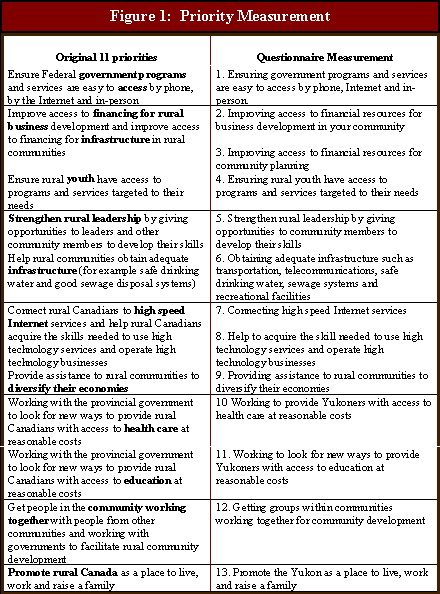 To gain a basic understanding of the relative importance of the 11 priorities, their measurement often required simplification of the content and wording. For example, the priority that states: "Working with the provincial government to look for new ways to provide rural Canadians with access to health care at reasonable costs" was measured by asking the more general question: "How important is working to provide Yukoners with access to health care at reasonable costs?" . In two cases measurement of the corresponding priority was done with two questions. For example, for the priority "connect rural Canadians to high speed Internet services and help rural Canadians acquire the skills needed to use high technology services and operate high technology businesses" it was necessary to ask one question measuring the importance of providing high speed Internet service and the other question the issue of developing high-tech skills. In addition to asking about the importance of each priority, respondents were also asked to rate government's performance in providing the priority to the community and to indicate which five priorities were the most important and needed the most attention in their community. Based on the later question, the sample of Yukoners who indicated that a priority was one of their five most important were then routed to more specific questions about that priority. Hence, the number of respondents answering these more detailed questions varies considerably with the most important priorities having the highest number of cases (see "Detailed Findings of the 11 Priorities" for a more complete discussion of this issue). Before conducting the survey, the questionnaire was pre-tested on 12 respondents. Minor modifications were made to the survey instrument as a result of this pre-test. B.2 Sample Design, Data collection, and Weighting The population of interest designated for telephone interviewing were all people 18 years of age or older who were currently residing in a dwelling unit in the Yukon that could be contacted by direct dialing. As with any telephone-administered survey, certain categories of residents are excluded from the database. These include people living in a household without a telephone, those who use mobile or cellular phones as their household number, those residing in a collective or temporary dwelling (e.g. long-term care facilities, correctional institutions, or temporary group residences), and residents of the Yukon without a permanent home. In the spring of 2001, a total 902 telephone surveys were completed by the data collection agency (DataPath Systems), for a response rate of 36%. Household residents are increasingly subject to telephone solicitation for fundraising, market research and sales. As a result, some householders are reluctant to participate in telephone surveys. The increased use of Call Display and other personal call management services by household residents have had a noticeable impact on study response rates in recent years. These factors likely have contributed to the moderate response rate for this survey. About 60% of the non-response was because potential respondents refused to participate in the survey. The remaining non-response (40%) was due to the inability to contact potential respondents (e.g. out-of service numbers, business / fax / modem numbers). To ensure sufficient sub-sample sizes for statistical reporting purposes, a minimum quota of 100 surveys was completed for Whitehorse and the four regions of the Yukon (South, North Highway, Central and North). Communities within regions were randomly surveyed based on their share of the total population for that region. Figure 2 presents the population parameters, sample sizes and confidence intervals for each region and for selected socio-demographic characteristics The total sample results presented in this report are statistically significance at the 0.5 level. With a sample size of over 900 respondents, we can be certain that 95% of the time the total sample results are accurate within a range of plus or minus 3.2 percentage points. These confidence intervals, however, are not applicable for sub-sample comparisons which contain a greater margin of error. When examining the results by gender, for example, confidence intervals are just over 4 percentage points. The much larger confidence intervals for the age categories suggest the data presented for these sub-groups should be viewed as general indicators rather than as statistical representations. The confidence intervals presented in Figure 2 apply to questions that were posed to all respondents. They do not, however, apply to the specific series of priority questions that were only asked to respondents who indicated that the priority was one of their five most important. In addition, for many of the specific priority questions, response rates were low. Hence, responses to these more detailed questions (Sections F through H) have been interpreted with caution. While the distributions for most of the sub-sample characteristics resemble the population parameters for the Yukon (e.g. 20% of Yukoners are Aboriginal compared to 16% of sample), this is not the case for the Whitehorse/rural sample distributions (Figure 2). Since the sampling procedure involved establishing a 100-respondent minimum for each region of the Yukon, the total sample does not replicate the true population parameters of the Yukon. For example, 64% of Yukoners reside in Whitehorse compared to only 29% of the sample. Hence, to establish a representative urban/rural distribution, total sample results were calculated by weighting Whitehorse by a factor of 2.2 and the rural areas by 0.5. These weights are only used when presenting total sample results since weighting is not appropriate for sub-sample results. 
Thirteen questions were included in the survey to determine the relative importance Yukoners place on the eleven priorities previously identified by rural Canadians. As noted in Section B above, the eleven priorities were measured in terms of their general area of concern, and for two priorities, two questions were required. Respondents were invited to indicate the importance attached to the 13 priority questions on a five-point scale with '1' representing "not important" and '5' "very important." The sample of Yukoners were also asked to provide their top five most important priorities among those they had indicated as a '4' or '5' on the five-point importance scale. We begin by examining the results from the thirteen priority scale questions. C.1 Importance of Priorities Figure 3 shows that a majority of respondents felt that the priority in question was either "important" or "very important" (those reporting '4' or '5' on a five-point scale) for their community development. Still, there are clearly some notable differences in the importance attached to each priority by this sample of Yukoners. Top Five Priorities:
Accessible healthcare, accessible education and the provision of an adequate infrastructure were viewed as 'important' (responses of '4' or '5') by over 90% of respondents. Accessible healthcare was reported as important by the largest majority of responses (96%), with almost 80% indicating the priority was 'very important.' Access to education (94%), and an adequate infrastructure (92%) were also viewed as important priorities by a very large majority of respondents. Slightly fewer, but still a large majority of Yukoners, viewed access to youth programs and services (86%) and assistance to diversify the economy (81%) as important priorities for the development of their communities. Remaining Priorities: 
Yukon Versus Rural Alberta: 
Whitehorse Versus Rural Yukoners: 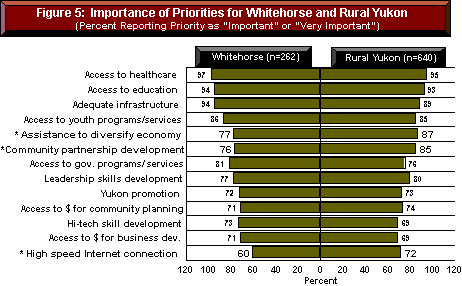
Gender, Age, and Aboriginal Status: Few noteworthy differences, however, are observed on the basis of age and aboriginal status. The consistency in responses is interesting since there are some priorities for which we would predict greater variation in the results. For example, we would expect younger respondents to attach greater importance to high speed Internet connection since they are more likely to be using this kind of computer-based technology. This is, however, not the case. In fact, older respondents were more likely to view high-tech skill development as important (77% of those 50 years of age or older compared to 69% of those under 36 years of age). The largest difference between aboriginal and non-aboriginal respondents is for the priority of promoting the Yukon as a place to live, work, and raise a family (80% of aboriginal compared to 72% of non-aboriginal respondents). 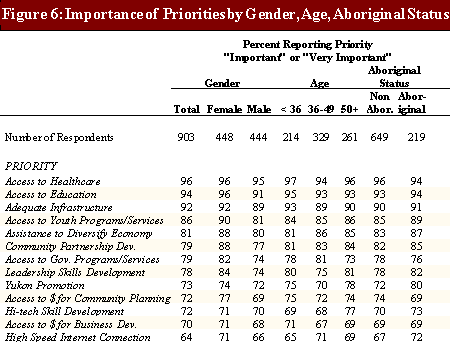 C.2 Priorities Needing Most Attention Measurement of the importance of the 11 priorities (13 questions) was also done by asking respondents to indicate which five priorities (among those they had indicated as 'important' or 'very important') were "most important" and needed "the most attention" in their community. The results for this question are examined by comparing them to the findings of the importance-scale questions presented in Figure 3.
The top five priorities that most respondents reported as important (Figure 3) are identical to the most frequently-cited, top-five priorities presented in Figure 7. These replicated results add to our confidence in concluding that Yukoners see healthcare, education, infrastructure, youth and economic diversification as the most important areas. The sample of Yukoners not only view these five priorities as important for their community, but they are also important in terms of needing the most attention. While there are a few changes in the order of the remaining priorities presented in Figure 7, the largest ranking change occurred for community partnership development, moving from 6th to last place. Hence, while community partnership development is a somewhat important priority, it is not one that Yukoners feel needs the most attention in their community.  Whitehorse Versus Rural Yukoners:
When comparing the top five priorities between Whitehorse and rural residents (Figure 8) and those presented in Figure 5 (above) some consistent patterns also emerge. Both measurements of the priorities indicate that Rural residents are more likely to view economic diversity, partnership development, and connection to high-speed Internet as important (Figure 5) and as needing the most attention in their community (Figure 8). Healthcare, education, and high-tech skill development, in contrast, were more likely to be one of the top five most important priorities among residents of Whitehorse, although these differences were not nearly as apparent in Figure 5. The similarities and differences in findings between the two methods of measuring the priorities suggest that some urban/rural differences are stronger than others. Economic diversity and high speed Internet connection are more important to rural Yukoners, no matter how the priority is measured. Somewhat less confidence can be placed on the greater interest among Whitehorse residents in healthcare, education, and high-tech skill development. Still, since these latter rural/urban differences are an indication of the priorities that need the most attention (rather than being important for the community), they should not be dismissed.  C.3 Other Important Priorities Just over half of the total sample (n=516) provided at least one other priority that "the government should be considering to improve the life in your community." A very wide variety of responses was provided, some of which were replications of the eleven priorities. Figure 9 presents the ten most common priorities provided after removing the redundant responses. Of these, about one-third provided 'land claims' as a response, followed by environmental concerns (27%), and job creation or employment (24%). Almost one in every five respondents providing an answer to this question indicated that the economy is a priority that governments should be considering to improve life in their community. Substance abuse, an issue that emerges in a variety of areas throughout this report, was another priority that 13% of Yukoners felt should be addressed. Some of the other priorities indicated by respondents (not presented in Figure 9) include day care, regulation reduction, seniors issues, and addressing prejudices in the community. 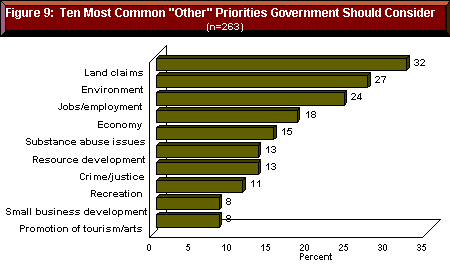
Respondents were also asked to rate how well government is doing in providing each priority to their community on a five-point scale, with '1 ' representing 'poor' and '5' indicating 'excellent.' Figure 10 presents the percentage of respondents indicating "good" (4) or "excellent" (5).
Access to healthcare stands out as having a much higher rating than all other priorities in terms of the governments' provision of this important priority, with 61% of Yukoners reporting "good" or "excellent." Four in ten respondents felt that the government is doing a good job providing adequate infrastructure and access to education. The sample of Yukoners were much less satisfied with the provision of the remaining priorities with economic diversification and access to financial resources for business development receiving the lowest positive scores (16%).  Whitehorse Versus Rural Yukoners:
As shown in Figure 11, respondents from Whitehorse were somewhat more likely to provide a favourable assessment of the government's provision of healthcare than rural Yukoners (63% compared to 56%). One interesting finding in this figure is the relative dissatisfaction that rural Yukoners reported for the provision of high speed Internet connection. We have already noted that rural respondents were more likely to view the Internet as important. Hence, we might speculate that Rural Yukoners are more likely to view the Internet as important and as needing the most attention because the government has been less likely to provide them with this service than those residing in urban Whitehorse. These differences, however, need to be interpreted by keeping in mind that high speed Internet connection is one of the lowest priorities among both urban and rural Yukoners. Lastly, while those residing in Whitehorse and rural Yukon were equally likely to report that the promotion of the Yukon is an important priority, rural respondents rated the government's performance on this priority as much lower (23% compared to 35%).  Gender, Age, and Aboriginal Status: 
The remaining sections of this report present the results of a series of more detailed questions that were asked of respondents about the eleven priorities. Most of these question were open-ended and have been grouped into meaningful response categories. Before discussing these results, however, a few words of caution need to be mentioned. It is important to remember that only those respondents who indicated that the priority was one of their top five were asked these more detailed questions. Hence, with smaller sub-sample sizes we cannot attach the same confidence to the findings as we have been able to for the results presented so far. Within this limitation, we can be the most certain about the results for the most important priorities since these questions were asked of a larger number of respondents (e.g. health, education, infrastructure). For other priorities, however, the results should be viewed as general indicators of trends and possibly as bases for further investigation. Additionally, the response rates for some of the questions were quite low, again suggesting caution in interpreting the findings. In the sections below, the number of respondents and the response rates are provided for each of the questions to allow an assessment of the quality of data being discussed.
E.1 Economic Diversity Economic diversity was the fifth most important priority and was rated relatively poorly in terms of the government's provision. Of the 432 respondents indicating that economic diversity was one of their top five priorities, 400 (93%) provided suggestions for the types of business or industry they would like to see developed in their communities (Figure 13). Topping the list of suggestions was the development of the tourist industry in the Yukon (34%), followed closely by mining which was offered as a suggestion by 27% of respondents. Considerably fewer respondents suggested logging/forestry (12%) or oil and gas (11%) development. Less than 10% of Yukoners would like to see the remaining industries or businesses listed in Figure 13 developed in their community. Among these, it is notable that although respondents were asked to comment on the types of business/industries, 3% provided answers that related to the provision of environmentally-conscious industry, no matter the industry type. Other suggestions offered by a few respondents (not shown in figure) included consumer services, retail, value-added, construction/development, or any small business.  The same respondents were also asked to comment on the major reasons why they thought new business opportunities had not been developed in their communities. Nine in ten eligible respondents provided an answer to this question (Figure 14). About one-quarter indicated that the remoteness of the Yukon, its sparse population or that there is nothing in the Yukon to develop as the most important reason for not being able to increase development in their community. One in five respondents mentioned reasons associated with insufficient funding or resources as the major reason, while 13% indicated too much government red tape and too little government support or still unsettled land claims as reasons for not developing new business. With regard to the later, it should be recalled that land claims was also the number one "other" priority offered by respondents. The results in Figure 13 suggest that the land claim issue is often couched by Yukoners within an economic or business framework. Somewhat fewer felt that there was simply no interest, initiative, or ambition among Yukoners to develop industry (9%) or that a poor economy (e.g. high unemployment rates, slow growth) prevented further development (8%). Six percent of respondents indicated that an overly-heavy reliance on existing industry prevented further development. The smallest proportion of respondents felt that Yukoners did not have the requisite knowledge, skills, or education to develop new types of industry in their community. 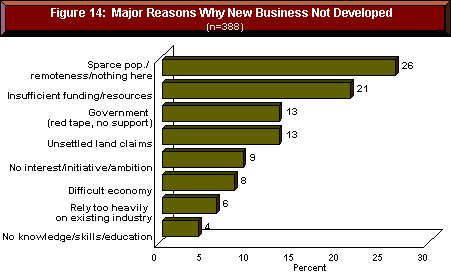 One interpretation of the responses to both questions on economic diversification is to conclude that since the Yukon is such a remote and sparsely populated area of Canada, Yukoners view this as a great opportunity to further develop the tourist industry by highlighting these very features. As we will see in Section G.6 below, a significant proportion of respondents felt that Yukon promotion could be facilitated by bolstering tourism in general and more specifically by making other Canadians aware of the beauty, purity, and safety to be found in such a remote area. Hence, on the one hand, the remoteness of the Yukon presents a barrier to industry development, on the other hand, it presents an opportunity for the development of tourism. A 93% response rate was received when respondents were asked whether they felt incentives should be given to "outside businesses to operate in your community" or to "help expand private businesses who are currently in your community." As Figure 15 clearly shows Yukoners are more than two times as likely to prefer that incentives (monetary or otherwise) be given to existing business. These findings were the same for Whitehorse and rural Yukon.  E.2 Business Development Improving access to financial resources for business development was ranked 12th Among the thirteen priority questions in terms of importance, but Yukoners were the least satisfied with how well the government has been doing in providing this priority to their community. About 70% (n=168) of eligible respondents provided an answer when asked to provide suggestions for how to improve access (Figure 18). The most often cited suggestion was to advertise, promote or educate about currently available resources. In other words, a large minority of respondents assume that the resources are available, but what they are and how to access them is not sufficiently publicized. In contrast, about one in five respondents suggested that more financial resources are needed. A similar proportion felt that access to finances for business development needs to be made easier by cutting red tape or by reducing the number of restrictions on who qualifies for financial support. One in ten indicated greater government involvement, support, or manpower would improve access. Fewer respondents felt that access should be broadened by ensuring that it was equal among all Yukoners or that more banks were needed. 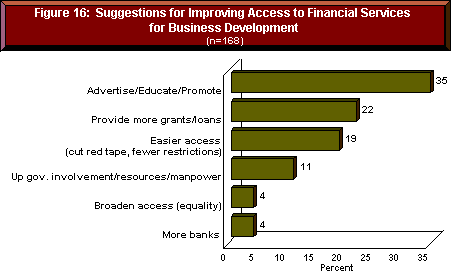
F.1 Youth-Related Issues Providing youth with access to programs and services targeted to their needs is the 4th highest priority and was rated favourably by only one in five respondents in terms of government provision. Of the 481 respondents who indicated that this was one of their top five priorities, 80% provided a response to the more specific question on the services or opportunities that are needed for young people in their community (Figure 17). The largest proportion of sample members suggested that more youth-oriented recreational activities, centres or programs was needed (40%). The second most common response was to enhance education linked to jobs in general (or high-tech skills, specifically) or life skills provided to youth. About one in five indicated more activities in general, while one in ten mentioned that the provision of more jobs, greater access to these jobs, and more job/career counseling would help. Other respondents felt that more resources should be devoted to creating centres, building shelters or counseling for troubled or high risk youth or that more substance abuse programs/education needs to be offered to young people in the community.  When asked the major reasons why young people leave the community, Figure 18 shows that most respondents mentioned a lack of work (77%) or educational opportunities (59%) in their community. Others simply acknowledged the curiosity among youth (perhaps that you would find anywhere) to explore the world and find adventure. In contrast to this 'pull' reason for leaving, 16% felt that youth were being 'pushed' out either because there was nothing to do in their community or that they had experienced problems in their family (12%).  F.2 Education Next to healthcare, access to education at a reasonable cost was viewed as the most important of the top five priorities by 70% of respondents (n=629). Education was rated relatively favourably by respondents in terms of government provision. Seventy-percent of sample members who rated the priority as one of their top five provided a response when asked what could be done to improve education in their community. As shown in Figure 21, most of these responses were related to making curriculum changes, including expanding the curriculum, focusing more on technology, job training, or trades, enacting more basic subjects, rigorous standard, or updating the curriculum to make it more current. One in five indicated that either better or more teachers would improve the education system and about the same felt that more or better facilities (both post-secondary and K - grade 12) would help to make the system better. Fifteen percent felt that more funding was needed. Other suggestions provided by somewhat fewer respondents were to get parents more involved in their children's education and to discourage youth from dropping out by promoting the importance of education or to simply promote what is offered in the various types of educational institutions. 
F.3 High-tech Skill Development High-tech skill development is ranked 10th in importance and 11th in terms of government provision. Of the 171 Yukoners asked to comment on how they thought high-tech skills and knowledge of computer or technical equipment could be developed in their community, 155 responded. Almost half reported that this should be done through formal post-secondary institutions such as Yukon College, and one in five suggested informal workshops or seminars as a way of developing these skills (Figure 20). One in ten indicated that more up-to-date courses or equipment needed to be provided and even fewer suggested that specific education targeted to youth would help.  F.4 Health and Healthcare Access to Healthcare at a reasonable cost was ranked as the single most important priority (using both measurements), but it also stood out as being the most favourable in terms of the territorial government's provision of healthcare. Rural Yukoners and aboriginal respondents (most of whom are from rural areas of the Yukon), however, were somewhat less favourable in their evaluations of government provision of healthcare. Despite this relatively positive evaluation, Yukoners provided a large number of suggestions for how to improve the healthcare system (Figure 21). The most often-cited suggestion dealt with providing more healthcare workers and specifically more physicians and nurses (34%). About half as many indicated that more or better facilities including seniors facilities, more or better services/programs or more health-related education or promotion would improve the healthcare system. 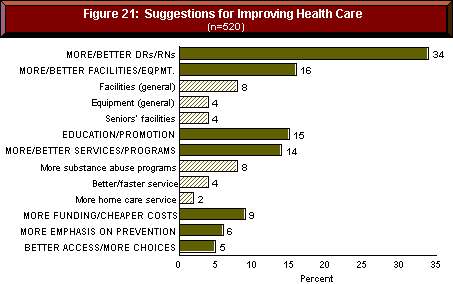 When asked to comment on what makes a person healthy, almost all eligible respondents had something to say. Many of the responses displayed in Figure 22 are as we would expect (e.g. exercise and diet), but a significant minority also mentioned such health contributors as having a positive mental attitude, having an adequate economy, job or income and having supportive or positive family or community relationships. Almost one in ten mentioned that a clean environment is an important contributor to one's health. The matter of not abusing alcohol, drugs, or cigarettes was also mentioned by about 10% of the sample. This latter area has emerged as an issue among Yukoners in a number of different ways throughout this report. Substance abuse was one of the ten most commonly-cited "other" priorities (Figure 9) offered by respondents and substance abuse programs was offered as a needed service for youth (Figure 15) and as a way of improving healthcare (Figure 19). While none of these substance-abuse suggestions were provided by a large number of respondents, the consistency with which this topic arose within a variety of priority areas suggests that it is an issue of great concern for some Yukoners. 
G.1 Community Leadership Skills Development The development of leadership skills in the Yukon was not viewed as a very important priority (ranking 12th), and the government's provision of this priority was evaluated relatively low with about one-quarter of the sample reporting that they were satisfied. In response to what could be done to encourage the development of leadership skills in the community, of the 135 responding to this question (out of an eligible 196), almost all suggested some form of education, whether it be education or training in general or workshops, specifically. G.2 Forging Community Partnerships Getting groups within communities to work together is not one of the most important priorities for Yukoners. It also received a relatively poor assessment in terms of government performance (25% of respondents were satisfied). Of the 184 respondents asked to comment on what types of partnerships could be improved, only 70 provided a response . Of these, the most common comments revolved around improving the relations between first nations and non-first nations people, followed by partnerships between government and business. G.3 Community Development and the Environment Improving financial resources for community development was the 10th most important priority among this sample of Yukoners and was rated as the 10th priority in terms of satisfaction with government provision. More detailed questions in this area revolved around environmental concerns and land use issues. All 228 eligible sample members provided a response when asked about the level of importance (on a five-point scale) of specific environmental and land use issues. Figure 25 presents the percentage of respondents reporting that the issue was "important" or "very important." A majority of Yukoners (whether urban or rural) indicated that wildlife protection, improving water quality, and land use planning for industry and residential use were important for their community. Land use planning and water quality, however, were seen as somewhat more important among rural Yukoners than those from Whitehorse. While seen as less important than the other issues, a large minority (46%) still viewed the addressing of climate change as important for their community. We have already mentioned that the environment was one of the most often-cited "other" priorities of this sample of Yukon residents (Figure 9). Environmental issues were also mentioned by respondents with regard to industry development (Figure 15) and for improving health (Figure 24). Together, the current and earlier findings provide further evidence that environmental issues are of great concern to some Yukoners.  Of the 228 respondents who were asked if there were any other areas they felt planning was needed, only 72 respondents provided an answer. These responses covered a wide range of topics including land use planning, employment or economic strategic planning, and planning around transportation (e.g. road development). G.4 Infrastructure Obtaining adequate infrastructure is one of the top three most important priorities among the sample of Yukon residents. The government's provision of this priority was also rated fairly positively. Of the 525 respondents indicating that it was one of their top five priorities, 92% provided an answer to the question, "What are the most important infrastructure needs in your community?" Figure 24 displays the categorized responses to this question. Transportation (mostly roads, but also bus and air transportation, and bridges), sewage systems or facilities, and clean / accessible water were the most frequently provided infrastructure needs. Since rural Yukoners were more likely to report that "improving the water quality" was an important concern in terms of community planning (Figure 23, above), we might also speculate that a larger sector of rural respondents indicated that clean and accessible water was an important infrastructure need in their community. Recreational facilities (including sports facilities, recreational halls or centres, and other facilities) were viewed as one of the most important infrastructure needs of the community by one quarter of respondents. One in five referred to telecommunications (improved phone system or Internet) or schools/educational facilities. More health-related facilities and utilities were mentioned by only 4% of this sub-sample. 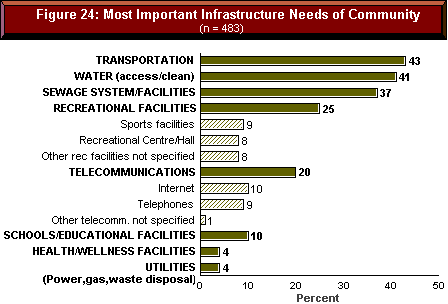 G.5 Internet Access Connecting high speed Internet services was the least important priority, although it was somewhat more important among rural respondents, and received an average rating on its provision. All eligible respondents (n=231) answered the questions on whether or not they personally had Internet access and if it was adequate for their needs (Figure 25). Almost two-thirds (64%) of this sub-sample of Yukoners had Internet access at the time of being interviewed, although a significantly greater proportion of Whitehorse residents had access (77% versus 60% in rural Yukon). Among those who had access, less than half indicated that it was adequate and again, urban/rural differences are significant. These findings help explain the greater importance that rural Yukoners attach to high-speed Internet connection and their lower levels of satisfaction with its provision. Not only are they less likely to have Internet access than Whitehorse residents, but most of those who do have it, do not feel it is adequate. By way of extrapolation, we might conclude that many rural Internet users are dissatisfied because they do not have high-speed connection for their Internet usage. When interpreting these findings, however, it must be recalled that only 27% of rural Yukoners viewed Internet access as one of their top five priorities. Hence, for a small proportion of the rural sample, high speed Internet connection is important and for an even smaller portion it is inadequate.  G.6 Promotion of the Yukon Promoting the Yukon as a place to live, work, and raise a family ranked 9th in importance (although it was more important among aboriginal respondents) and received the 4th most positive rating in terms of government provision. Just over half of the respondents who indicated that this was one of their top five priorities provided a response when asked to comment on ideas they had about Yukon promotion. As illustrated in Figure 26, the greatest number of suggestions had to do with boosting the economy (e.g. by generating more jobs or increasing trade or investment). Almost one-third suggested that some kind of marketing or advertising would help promote the Yukon. One in every five members of this small sub-sample provided the more specific response of promoting the Yukon as a clean, safe, and natural environment to outsiders either for the purpose of tourism or to attract more residents. 
This last part of the results component of the report presents responses to questions posed to only those respondents who indicated that access to government programs and services was a top five priority as well as a series of questions asked of the total sample on current modes of access and views on the content contained on the government's web site. We begin by examining the former results. H.1 Access Improvement Almost 80% of Yukoners indicated that ensuring government programs and services were easy to access by phone, Internet or in-person was an important priority, placing it in 7th place in terms of importance. One quarter of respondents indicated that the provision of this priority by the government was 'good' or 'excellent.' However, only 37% (n=82) of eligible respondents answered the question of how to improve access (results not shown in figure). Among these, the two most frequently provided suggestions were to advertise (e.g. pamphlets, mailouts) and to have "real people" to contact (e.g. on the phone, visits to communities by government officials). Other suggestions mentioned included seminars/workshops, phone access, Internet access, and more open access in general. H.2 Use and Potential Use of Government Access Services As mentioned, the remaining analysis presented in this section are based on results from the total sample. We begin with a series of questions on respondents' use or potential use of Service Canada's Single-Window Model. Included in this model are the 1-800 O'Canada Telephone Inquiry Centre, the Canada Web Site, and Service Canada Access Centres. In addition, respondents were asked to comment on how helpful it would be to have "Internet access through computers located at easily accessible places in your community such as libraries, town halls, or the College" and to have "workshops in your community with the federal, territorial, and First Nation government on services they provided."
As showed in Figure 27, about one in every five respondent had used a Service Canada Access Centre or the 1-800 O'Canada telephone line. Somewhat more (31%) respondents had used the government's web site. The proportion reporting that these types of access modes would be helpful, while much higher than the percentage using the access mode, follows a similar pattern of current usage. In other words, Service Canada Access Centres have been used the least and are seen as the least helpful and the web site is used the most and is perceived as being the most helpful way of accessing government services and programs. An even larger proportion indicated that Internet access through public computers would be helpful (82%) and about three-quarters provided a positive response to having workshops. 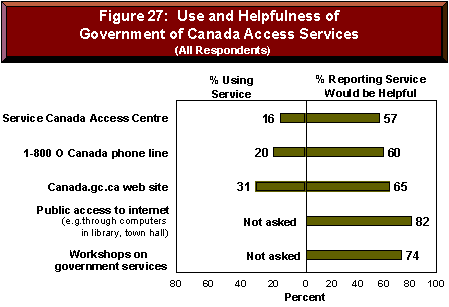
The perceived helpfulness of these three access services is influenced by whether or not they have been used and whether or not government access is seen as a priority. First, those who had used the service were more likely to report that it would be helpful. For those who had used a Service Canada Access Centre, 66% reported that it would be useful. Similarly, 76% of respondents who had used the 1-800 O Canada line stated that it would be useful and 81% of the government web site users indicated that this access service would be useful. Second, while those who indicated that access to government was an important priority were no more likely to have used these access services (than on average), they were much more likely to report that the access service would be helpful. Among those who targeted government access as an important priority, six in ten (compared to 46% of other respondents) indicated that a Service Canada Access Centre would be important, 64% (compared to 47%) that the 1-800 line would be important, and 67% (versus 56%) that Internet access to government services would be important.
Internet: The final questions asked of respondents dealt with the priority of putting specific services on the government's web site. Before presenting these results, however, a few findings on the Internet help situate this analysis. First, almost two-thirds (64%) of those who viewed the provision of high speed Internet as one of their five most important priorities (n=231) had Internet access. While these data apply to only one-quarter of the total sample, we can probably safely assume that at least half of Yukoners currently have Internet access and are therefore potential users of the specific web site services described below. Secondly, within the Service Canada Single-Window Model, respondents were most likely to have used the government's web site (31%). Hence, when examining respondents views of specific services, we present the total sample results as well as for those who have used the web site and for those who indicated that government access is a priority. As Figure 30 clearly illustrates, these later respondents were more likely to report (than on average) that the services were a priority ('4' or '5' on a five-point scale with '5' representing "a very high priority." In most cases, however, the differences between the total sample and these sub-groups are not large. Indeed, a majority of all respondents stated that access to these services on the Internet was a priority. Still, there are some differences in the priority attached to the services. More than three-quarters of the total sample viewed information on government programs and services and applications for government funding programs as a priority. In contrast, just over half indicated that application and renewal of hunting or fishing licenses and payment of fees as priority services that should be on the government's web site. 
The survey results presented on the priorities (Section D.1) provide fairly strong evidence that the majority of Yukoners view the 11 priorities as important to the development of their communities. Hence, the results support the prior findings from the Rural Dialogue initiative. The results further provide an indication of the relative importance Yukoners attach to the priorities. This survey provides solid evidence that Yukoners feel that healthcare, education, infrastructure, youth programs, and economic diversity are very important issues. We have also found, however, that the importance of these priorities and the satisfaction with the provision of the priorities are not necessarily the same thing. Rather, the analysis suggests that Yukoners can feel that an issue is a high priority while at the same time indicate that they are relatively satisfied with its provision. Healthcare stands out as an example. Access to healthcare at a reasonable cost was the highest priority (no matter how it was measured), but Yukoners were also the most satisfied with the provision of this priority than any other. Regardless, this satisfaction must not lead to complacency on the part of service providers. Rather, Yukoners clearly expressed that healthcare was the highest priority and needed the most attention in their community. Close attention must be paid, then, to healthcare, education, and infrastructure. Priorities that were not prompted and thus not rated relative to the eleven priorities should be given much weight. Land claims and the environment stand out as very important to Yukoners. Both priorities would be surpassed, however, if the priority of "employment" were combined with the closely related "economy." Government, then, should ensure that Yukoners continue to receive high quality, affordable healthcare. Because only 40% of Yukoners are satisfied with government delivery/provision of infrastructure and quality education, yet both issues rank near the top of the priority ranking scale, much attention should be paid to improving service delivery in these areas. Four Building Blocks
YUKON PRIORITY QUESTIONNAIRE FINAL Hello, this _________, from DataPath Systems. We're a Yukon based market research firm, and today we are conducting a survey on behalf of The Federal and Yukon governments and the Council of Yukon First Nations. The survey seeks your opinions on priorities identified across rural and remote areas of Canada and how important you feel those priorities are in your community. This will help to develop the right solutions for your area. (IF NOT AN ADULT HOME - CALL BACK) Would you prefer this survey be given in English or French? (IF FRENCH SCHEDULE CALL BACK) First I would I like to ask you to review the priorities that were identified during public meetings across rural and remote Canada. For each item please tell me first how important that priority is in your community, and then how well you feel the FEDERAL government is doing on providing it in your community. 1) Use a scale from a low of 1 to a high of 5, where a 1 means not important and 5 means very important. FOR YOUR COMMUNITY, how important is: _______ (ASK Q2, BEFORE GOING TO NEXT ITEM) 2) And from 1 to 5, where 1 means Poor and 5 means Excellent, how well is government providing ______ (READ UNDERLINED PART). 3) Those priorities covered such issues as employment through economic development, education, youth employment, health care, communication and technology. Do you feel there are any other priorities the Governments should be considering to improve life in your community? (LIST TOP 5) (DO NOT READ LIST) 4) You mentioned the following priorities are very important to you: (READ LIST OF ITEMS RATED A 4 or 5 IN Q1, PLUS ITEMS LISTED IN Q3). 5) (FOR TOP 5 ITEMS) b) (IF b IS MENTIONED) c) (IF c IS MENTIONED) d) (IF d IS MENTIONED) e) (IF f IS MENTIONED) f) (IF g IS MENTIONED) g) (IF h IS MENTIONED) h) (IF i IS MENTIONED) i) (IF j IS MENTIONED) k) (IF k IS MENTIONED) l) (IF l IS MENTIONED) m) (IF m IS MENTIONED) n) (FOR OTHER MENTIONS) ASK EVERYONE Now think specifically about government services which could be provided over the internet. 6) Can you think of a government service you would like to be able to access by the internet? (yes/no/don't have internet). And now, just a few questions for classification purposes only. 8) What year were you born? Would you like to get the results of this survey mailed to you? (IF YES, RECORD ADDRESS) Your name and address will not be correlated to the answers you gave on the questionnaire and will be protected under the provisions of the Privacy Act and will be stored in Personal Information Banks AAFC/PPU-301, 302, and 303. Some information may be accessible or protected as required under the provisions of the Access to Information Act. Record Gender That concludes our survey. If you are interested in knowing more about what the Government of Canada is doing in rural communities, or if you think of something else you would like to add to your comments, please visit our web site at www.rural.gc.ca and select the Yukon Dialogue icon. Thank you very much for participating. We appreciate your time and thank you for your interest.
  
|
